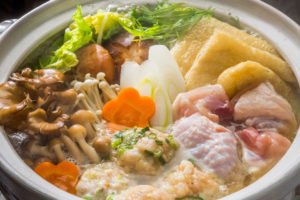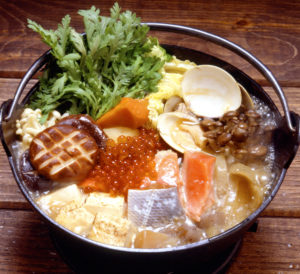
Nabe: Japanese Hot Pot
“Nabe” in Japanese refers to a dish where several ingredients are stewed together in a pot. Many types of ingredients are added on to the pot creating a rich and tasty broth. People gather around it while it’s cooking usually on a portable gas stove on a table. They share the food by placing portions on individual plates and bowls. Nabe is an all-in-one dish with proteins, vegetables and carbohydrates in one cooking pot.
Nabemono (鍋物, なべ物), nabe “cooking pot” and mono “thing”, or just simply nabe, is actually a variety of Japanese hot pot dishes, also known as one pot dishes or “things in a pot”. Nabe is very popular in Japan because it’s affordable, nutritious and is perfect for getting warm in cold months.
Check out the types of nabe dishes below!
Chanko nabe – is synonymous to sumo wrestlers. It’s a type of Japanese hot-pot stew that is eaten in large amounts by sumo wrestlers as part of a weight-gain diet. The dish consists of chicken broth or dashi soup base with mirin or sake for flavor. There is no precise recipe for chanko nabe. The ingredients of the dish are often seasonal and whatever is available in the kitchen. The bulk component of chanko nabe is protein, which can be chicken with the skin on, fried fish balls, beef, tofu, and vegetables. The dish is actually reasonably healthy though protein rich. It’s just the gigantic portions that make the dish ideal for sumo wrestlers to gain weight.
Shabu-shabu – is a delightful assortment of meats and vegetables. Meats may include beef, crab, duck, fish balls, or lobster. Vegetables may include Chinese cabbage (hakusai), nori (sea weed), chrysanthemum leaves, welsh onions, green onions, garlic, mizuna, carrots, shitake mushrooms, bean noodles, or lotus root. The broth is made boiling at least three inches of sea kelp (kombu) for around 30 minutes. The broth may also have some saki and salt mixed in. Shabu-shabu comes with two types of sauce. Commonly, one sauce is made with sesame paste, soy sauce, fish sauce, vinegar, sugar, water, and fine garlic pieces, while the other sauce is a combination of lime juice, soy sauce, and chopped long green onions.
Ishikari nabe – is a local dish of Hokkaido. Salmon is abundant in the region and the dish is made with raw salmon as the main ingredient with miso as the base. Ishikari nabe was originally a staple for local fishermen. The more recent version for the broth is made from miso and kombu to stew the salmon meat or other leftover fish parts from filleting, tofu and vegetable. Butter, milk or sake can be added to make a richer broth.


